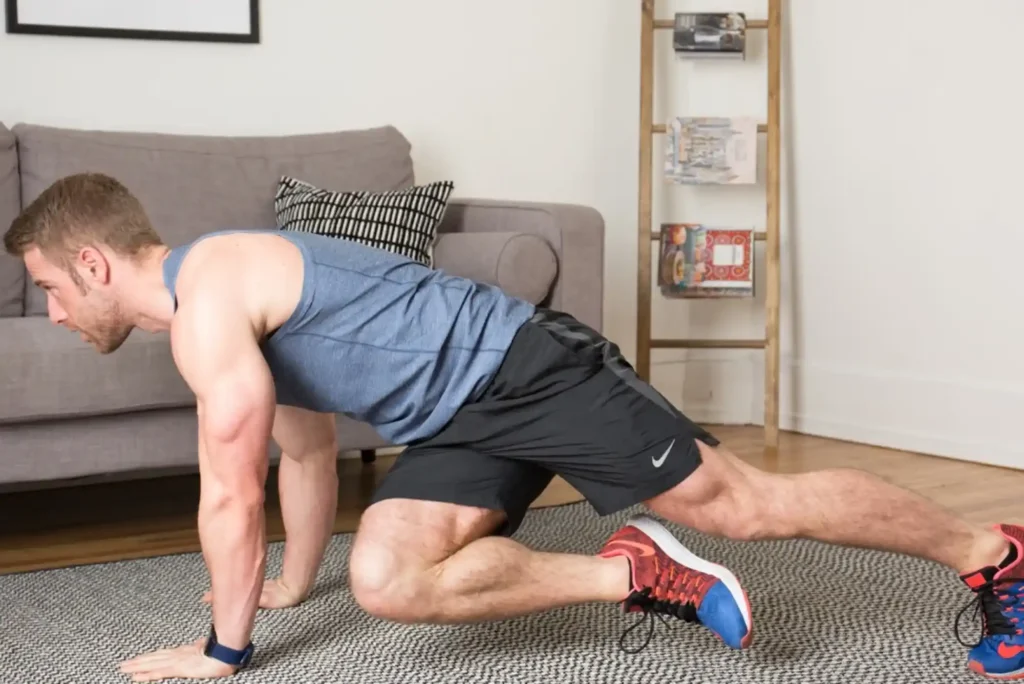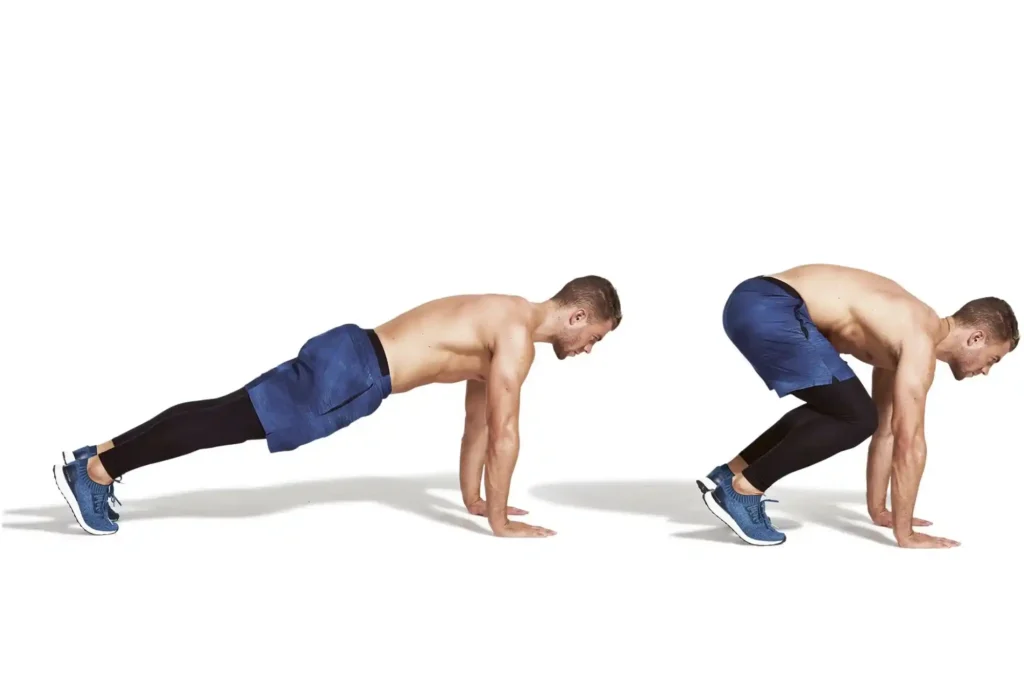Bodyweight exercises are an essential component of any fitness routine, especially when aiming to build strength and endurance without relying on weights. Among these exercises, bodyweight skull crushers have gained popularity for their effectiveness in targeting the triceps and improving upper body strength.
However, the question often arises: How much time for archer position bodyweight skull crushers is healthy? This article will explore the benefits, form, and appropriate duration for performing this exercise in a way that maximizes your health and fitness.
What Are Bodyweight Skull Crushers?
Understanding the Exercise
Before diving into the time duration for performing bodyweight skull crushers, it is important to understand what this exercise entails. Skull crushers, traditionally performed with weights, are designed to target the triceps, the muscles located at the back of the upper arm. In the bodyweight variation, the exercise is adapted to use the individual’s own body weight for resistance.
The bodyweight skull crushers can be performed in several positions, but the archer position is particularly challenging and effective. In the archer position, one arm is extended out to the side, while the other arm performs the tricep-dominant movement, providing an intense unilateral workout.
Benefits of Bodyweight Skull Crushers
- Strengthens the Triceps: As the primary muscle targeted, the triceps are activated during each repetition, leading to improved muscle definition and strength.
- Engages Core Muscles: In the archer position, your core muscles engage to stabilize your body, adding a functional benefit to the exercise.
- No Equipment Needed: Since it uses bodyweight, this exercise is convenient and can be done anywhere, making it perfect for home workouts.
- Improves Joint Mobility: The controlled movement helps improve elbow joint flexibility, which is vital for overall upper body health.
How to Perform the Archer Position Bodyweight Skull Crusher
Step-by-Step Instructions
- Start in a Plank Position: Begin by assuming a push-up position, with your hands placed slightly wider than shoulder-width apart.
- Shift into the Archer Position: Move one arm out to the side, extending it fully. Keep your other arm bent as you lower your body towards the ground.
- Lower Your Body: Keeping your body straight and your elbows tracking properly, lower your chest toward the floor as you bend the working arm.
- Push Back Up: Push yourself back to the starting position, ensuring that the triceps of the bent arm are doing most of the work. Alternate arms and repeat.
Common Mistakes to Avoid
- Poor Hand Placement: Ensure your hands are firmly planted, with fingers spread wide for stability.
- Flared Elbows: Keep your elbows tucked in to protect your shoulder joints and maintain proper form.
- Arching the Back: Engage your core throughout the movement to avoid putting strain on your lower back.
How Much Time for Archer Position Bodyweight Skull Crushers Is Healthy?

When incorporating bodyweight skull crushers into your workout routine, it’s essential to focus on quality over quantity. The duration or time spent on the exercise should depend on your fitness goals and experience level.
Beginner Level
If you’re new to bodyweight exercises or tricep-specific movements, start with short sets of 10-12 repetitions per arm. Perform 2-3 sets and rest for 60-90 seconds between sets. This will help you build strength and get accustomed to the movement pattern.
Intermediate Level
For those who have experience with bodyweight exercises, you can extend your sets to 12-20 repetitions per arm. Perform 3-4 sets with 60-90 seconds of rest. At this level, you should focus on improving your form and increasing the number of repetitions.
Advanced Level
Advanced individuals can push themselves to 20-30 repetitions per arm in a set. Perform 4-5 sets, with a rest period of 60 seconds or less. At this stage, you should be focusing on maximal strength development and endurance.
How Often Should You Perform Bodyweight Skull Crushers?
The frequency of performing bodyweight skull crushers will depend on your overall workout plan. If you are focusing on upper body strength, performing this exercise 2-3 times per week with adequate recovery time is ideal. It’s important to allow for at least 48 hours of rest between sessions to prevent overtraining and injury.
Why Archer Position is Effective for Bodyweight Skull Crushers
The archer position is a popular and highly effective variation of bodyweight skull crushers, offering several benefits that make it a standout choice for targeting the triceps and building upper body strength.
This advanced position adds a layer of difficulty to the standard skull crusher, forcing you to use more strength, stability, and control throughout the movement. Let’s explore why the archer position is particularly effective for bodyweight skull crushers and how it helps enhance muscle growth and strength development.
Increased Range of Motion
The archer position allows for a greater range of motion (ROM) compared to traditional bodyweight skull crushers. When performing the movement in the archer position, one arm is extended out to the side, while the other arm bends to perform the skull crusher. This variation significantly increases the depth of the movement, as the bent arm can lower your body closer to the ground.
- Why It Matters: A greater range of motion means more muscle fibers are recruited, which leads to better muscle activation and growth. The deeper you go in the movement, the more tension you place on the triceps, resulting in increased muscle engagement.
- Example: In a standard push-up position, your elbows may only bend to a certain degree. In the archer position, as one arm moves out, you can go deeper into the exercise, allowing the triceps to stretch more and engage fully throughout the lift.
Unilateral Focus
The archer position bodyweight skull crushers are inherently unilateral, meaning one arm does most of the work at a time. While the non-working arm remains extended or supports part of the body’s weight, the working arm bears the majority of the load.
- Why It Matters: This unilateral setup forces each arm to work independently, improving balance and strength on both sides of the body. Unilateral exercises are especially effective at correcting muscle imbalances, allowing you to build symmetry and focus on weaknesses. By alternating between arms, you ensure that both sides of the triceps receive equal attention.
- Example: For individuals with one weaker arm, performing the archer position can help bring balance, as the non-working arm is allowed to stay extended and isn’t actively engaged, which reduces the risk of overcompensating.
More Triceps Activation
The main muscle group targeted during bodyweight skull crushers is the triceps. The archer position forces the triceps to work harder due to the increased stability demands and greater range of motion.
- Why It Matters: By placing the triceps under more tension through a longer range of motion, you enhance muscle activation. As the movement becomes more challenging, the body recruits more muscle fibers, leading to increased muscle growth and strength. This is crucial for anyone looking to improve their tricep size, tone, or overall strength.
- Example: As the body lowers closer to the ground in the archer position, the tricep is stretched further during the eccentric phase (the lowering part of the movement). When pushing back up, the tricep contracts harder, leading to a more effective and thorough workout.
Core Engagement and Stability
In the archer position, the body must maintain balance and stability due to the unilateral nature of the movement. This forces the core to activate in order to keep the body steady and aligned throughout the exercise.
- Why It Matters: An engaged core not only ensures proper form but also helps protect the spine and lower back from strain. By maintaining a solid core throughout the movement, you also improve overall body control, which is key for progressing in more challenging exercises.
- Example: When performing the archer position bodyweight skull crushers, the shifting of weight to one arm places more stress on your core. This leads to better development of the abdominal and oblique muscles, making it a full-body exercise rather than just an isolated arm movement.
Progressive Overload Potential
The archer position increases the intensity of the bodyweight skull crushers by shifting more bodyweight to one arm. This makes it a great option for those looking to progressively overload their muscles without adding external weights. Progressive overload is a principle that involves gradually increasing the difficulty of exercises to continue making gains in strength and muscle mass.
- Why It Matters: As you get stronger in the archer position, you can increase the number of repetitions, sets, or time under tension, making it possible to keep challenging your muscles. This can lead to continuous progress and improvements in strength without having to rely on additional weights or equipment.
- Example: After you’re comfortable with standard bodyweight skull crushers, you can advance to the archer position, which is a natural progression in difficulty. As your arms and triceps adapt, you can increase the volume or change up the tempo to keep your muscles progressing.
Lower Impact on Joints
Although the archer position is a more advanced variation, it is still a bodyweight exercise, which typically places less strain on the joints compared to weighted exercises like skull crushers with dumbbells or barbells. The absence of added weights makes it a safer option for people who might experience joint discomfort but still want to build strength.
- Why It Matters: The archer position bodyweight skull crushers provide a low-impact way to build triceps strength while minimizing the risk of joint strain or injury. This makes them an excellent option for individuals who are recovering from an injury or looking for a safer alternative to more traditional, weighted exercises.
- Example: If someone has shoulder issues, performing archer position bodyweight skull crushers can offer a safer way to work the triceps, as the exercise uses bodyweight and doesn’t put added pressure on the shoulders like heavy lifting might.
Improved Mobility and Flexibility
Due to the wider range of motion required in the archer position, this variation of the skull crusher can help improve shoulder, elbow, and wrist mobility. As you stretch and contract your muscles through the movement, it encourages joint flexibility and proper alignment.
- Why It Matters: Mobility is critical not only for performance in exercises but also for injury prevention. By consistently practicing the archer position, you can enhance your overall flexibility, which will help you perform a wide range of exercises with better form and less risk of injury.
- Example: The deeper stretch involved in the archer position can lead to improved flexibility in the shoulder joints, which is essential for overall upper body health. As you lower into the skull crusher, you stretch the triceps, forearms, and shoulders, leading to better joint mobility.
Targeting the Entire Upper Body
While the triceps are the primary target, the archer position bodyweight skull crushers engage several other muscle groups. The chest, shoulders, and even parts of the back are recruited to stabilize the body, making this a more comprehensive upper-body exercise.
- Why It Matters: Engaging multiple muscle groups helps build overall upper body strength and muscle mass. The archer position isn’t just about the triceps; it provides a great workout for the entire upper body, making it an efficient and effective exercise choice.
- Example: As the triceps extend and contract, the chest and shoulders work to stabilize the movement, especially as you push back up from the lowered position. This creates a compound effect that helps build overall upper body strength.
Tips for Maximizing the Effectiveness of Bodyweight Skull Crushers

- Warm-Up Properly: A proper warm-up is crucial for preventing injuries. Focus on dynamic stretches that target the arms, shoulders, and chest.
- Maintain Proper Form: Always prioritize form over the number of repetitions. Poor form can lead to injury and diminish the effectiveness of the exercise.
- Control the Movement: Slow down the movement to maximize muscle tension during both the lowering and lifting phases.
- Combine with Other Tricep Exercises: Incorporate a variety of tricep exercises, such as push-ups and dips, to target the muscle from different angles.
How to Progress with Archer Position Bodyweight Skull Crushers
Progressing in bodyweight skull crushers, especially in the challenging archer position, requires a strategic approach. As your strength and skill improve, you can gradually increase the difficulty to ensure continuous progress. Below are key methods for advancing with the archer position bodyweight skull crushers, from basic modifications to more advanced techniques.
Increase Repetitions and Sets
One of the simplest ways to progress with bodyweight skull crushers is by gradually increasing the number of repetitions or sets you perform. As you become more comfortable with the exercise, aim to challenge yourself by doing more reps within each set or adding additional sets to your routine.
- Repetitions: For example, if you start with 10 repetitions per arm, aim to increase the repetitions by 2-5 per arm each week as your strength builds. For advanced athletes, performing 20-30 reps per arm is a great goal.
- Sets: Adding extra sets will further increase the time under tension for your muscles, which is key for growth and endurance. Start with 2-3 sets and work up to 4-5 sets per session.
Slow Down the Movement for Increased Tension
Speed can significantly affect the intensity of your workouts. By slowing down both the lowering (eccentric) and raising (concentric) phases of the bodyweight skull crushers, you will place more tension on your triceps and enhance muscle growth. This technique is called “time under tension” (TUT), and it forces the muscles to work harder, resulting in more significant gains.
- Eccentric Phase: Focus on lowering your chest toward the ground slowly (about 3-5 seconds). This slower movement recruits more muscle fibers and increases the time your triceps are under load.
- Concentric Phase: Push yourself back up with control, maintaining a steady pace instead of using momentum. Aim for a 2-3 second push-up phase.
This slow, controlled method is especially effective when you’re aiming for muscle hypertrophy (muscle growth).
Incorporate Weighted Variations
Once you’ve built a solid foundation with bodyweight skull crushers, you can make the exercise more challenging by adding extra weight. Here are a few variations to incorporate:
- Weighted Vest: Wearing a weighted vest adds resistance to your bodyweight, making each rep more difficult. Start with a small amount of weight and increase as you get stronger.
- Backpack with Weights: If you don’t have access to a weighted vest, fill a backpack with some weight (dumbbells, books, etc.) and wear it while doing the exercise. This will simulate the same challenge as a weighted vest.
- Resistance Bands: Attach a resistance band to a stable object and loop it over your back to add resistance during the concentric phase of the movement. Resistance bands are particularly effective for increasing difficulty during the push-up phase.
Elevate Your Feet for More Intensity
Elevating your feet during bodyweight skull crushers changes the angle of the exercise and increases the workload on your upper body. This variation forces you to work harder and engage more muscle groups to stabilize your body.
- How to Do It: Place your feet on a raised surface such as a bench, box, or platform. The higher the elevation, the more challenging the movement becomes. As your feet rise, more of your bodyweight is shifted towards your upper body, making it a more demanding exercise for your triceps and shoulders.
- Benefits: This version also engages the core more actively to help maintain body control, adding an extra challenge to the exercise.
Try Unilateral Variations
While bodyweight skull crushers already target one arm at a time in the archer position, you can make the exercise even more advanced by switching to a full unilateral (one-arm) variation.
- How to Perform: Instead of using both arms in the archer position, perform the movement with just one arm at a time, leaving the other arm either extended or resting on the ground.
- Why It’s Effective: Doing a full unilateral version forces the working arm to do all the work, increasing intensity and helping to develop more strength in the triceps. This version also provides a more focused contraction, which can help improve overall muscle symmetry and strength balance.
Increase Volume with Supersets and Circuits
To accelerate your progress, you can include bodyweight skull crushers in supersets or circuits with other tricep or upper body exercises. This method helps increase training volume and intensity, promoting faster gains in both strength and muscle endurance.
- Superset Example: Pair bodyweight skull crushers with another tricep exercise, such as tricep dips or push-ups, and perform them back-to-back with no rest in between. This method will fatigue your muscles more quickly, leading to greater gains.
- Circuit Example: You can include bodyweight skull crushers in a full-body circuit, alternating between exercises like push-ups, pull-ups, and planks. This method improves muscular endurance and overall strength.
Focus on Form and Flexibility
To progress safely, maintaining proper form is crucial. As you perform bodyweight skull crushers, it’s important to ensure your body stays in the correct alignment to avoid injury and maximize the effectiveness of the movement. Here are some tips:
- Core Engagement: Always engage your core to protect your lower back. This becomes even more important as you increase intensity or add weight.
- Elbow Tracking: Keep your elbows pointing directly behind you as you lower your body. Avoid flaring them out, as this could lead to shoulder or elbow strain.
- Wrist Alignment: Ensure your wrists are aligned with your forearms throughout the movement to avoid unnecessary stress on the wrists.
Incorporate Recovery Strategies
Muscle growth and progression aren’t just about pushing harder each time. Recovery plays a significant role in strength development. Ensure you are recovering properly between workouts to allow your triceps muscles to repair and grow stronger.
- Active Recovery: Incorporate lighter, restorative movements or stretches into your routine to maintain flexibility and circulation.
- Rest and Nutrition: Allow adequate rest between sessions and focus on a diet rich in protein, healthy fats, and carbohydrates to support muscle recovery.
People Also Ask
1. What muscles do bodyweight skull crushers target?
Bodyweight skull crushers primarily target the triceps, but they also engage the chest, shoulders, and core, particularly when performed in the archer position.
2. How can I make bodyweight skull crushers easier?
If you’re struggling with the movement, reduce the range of motion or perform the exercise with your knees on the ground for added support.
3. Can I do bodyweight skull crushers every day?
While bodyweight skull crushers are effective, doing them every day is not recommended due to the risk of overtraining. Aim for 2-3 sessions per week.
4. Are bodyweight skull crushers good for building muscle?
Yes, bodyweight skull crushers are excellent for building muscle, particularly in the triceps, when performed consistently and with proper form.
Table: Recommended Sets and Repetitions for Different Fitness Levels
| Fitness Level | Repetitions (per arm) | Sets | Rest Period |
|---|---|---|---|
| Beginner | 10-12 | 2-3 | 60-90 seconds |
| Intermediate | 12-20 | 3-4 | 60-90 seconds |
| Advanced | 20-30 | 4-5 | 60 seconds or less |





